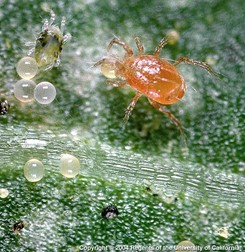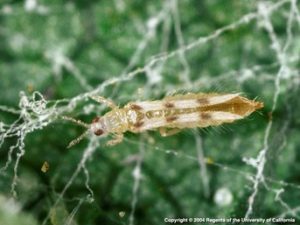David Haviland, UC Cooperative Extension, Kern Co.
In a tight fiscal year, the decision of whether or not to make a hull split spray is an easy one: do it. However, the number of hull split sprays, and how much money to put in the tank during each spray, are valid topics for discussion.
Navel Orangeworm
On an annual basis, all almond growers in the Sacramento Valley should invest in an insecticide application for navel orangeworm at the initiation of hull split. At this time, the second flight of navel orangeworm begins at the same time as Nonpareil nuts begin to split, making them susceptible to attack. However, the benefits of this spray go beyond the protection of early-splitting Nonpareils.
During the summer, it takes approximately one month for navel orangeworm (NOW) to complete a generation. Loosely speaking, this means that eggs that hatch in mid-July will become moths that lay eggs that hatch in mid-August, that in turn grow up to become moths that lay eggs in mid-September. This means that if you kill the egg in mid-July, you prevent its production of offspring in mid-August and mid-September.
Additional protection of nuts can be achieved without additional cost through timely harvest. More specifically, early varieties that are harvested before the beginning of the third NOW flight, or late varieties like Monterey that are harvested before the fourth flight, typically have reduced damage than when the same varieties are harvested one to two weeks later, after the respective flights begin.
On a case-by-case basis, almond orchards may require a second hull split spray for NOW, especially if a fourth flight or delays in harvest are anticipated. When determining whether or not to invest in a second hull split spray in the Sacramento Valley, consider asking the following questions: 1) how much damage did I have last year in this orchard, 2) how good was my sanitation, 3) did I invest in mating disruption, 4) what risk do I have from neighbors, 5) how do my pheromone trap captures compare to historic numbers in the same orchard, and 6) when do I plan on harvesting? Interpreting the answers to these questions is more of an art than a science, so the key is to look for trends. For example, getting a positive return on investment for a second NOW spray is unlikely for growers who had acceptable damage last year, had decent sanitation, plan on harvesting early, and are not located near a ‘dirty’ neighbor. To the contrary, growers with a history of damage, next to poorly managed orchards, and that anticipate delays in harvest, would likely get a positive return on investment in a second hull split spray.
The standard insecticides for NOW are Intrepid and Altacor. They have good efficacy on NOW eggs and young larvae and do not disrupt biological control. Also available are Intrepid Edge and pyrethroids such as Brigade and Warrior. However, these products kill sixspotted thrips – the primary predator of spider mites – such that a positive return on investment in the battle against NOW can be off offset by flare-ups of spider mites, additional miticide costs, and economic losses associated with defoliation.
Spider Mites
Hull split sprays also present an opportunity to save costs by integrating miticides – if needed – into a hull split spray. When making spider mite management decisions at hull split, almond growers have three choices, 1) do nothing by relying exclusively on biological control, 2) apply oil, or 3) apply a miticide. The key to determining which of these options is appropriate is to assess the status of biological control.
In the Sacramento Valley there are two main predators to look for. The first are species of predatory mites (phytoseiids, Photo 1). These are good mites that eat the bad mites. Phytoseiids have a tear-dropped shape, a shiny appearance, and are often seen running around on leaf surfaces in search of food. They have historically been the main predators found in almond and walnut orchards in the Sacramento Valley.

Photo 1. Predatory mite (right) eating the eggs of a spider mite (left) (Photo: UC IPM).
The second predator that has become increasingly important over the past few years is the sixspotted thrip (Photo 2). This predator feeds almost exclusively on mites, can double its population every 4 days, thrives in hot dry conditions, and loves to navigate within spider mite webbing in search of food.

Photo 2. Sixspotted thrips, characterized by three dark spots on each of its two fringed wings (Photo: UC IPM).
The most effective method for monitoring sixspotted thrips is to place two “Predator traps” in each orchard. This trap can be purchased through Great Lakes IPM and can be hung in the tree using a binder clip and a paper clip. This video from UC IPM shows how this is done. Research has shown that beginning at hull split, mite populations stay the same over a one-week period if 3 sixspotted thrips are caught per trap in a week. After 14 days, mite populations have consistently decreased.
Changes in natural enemy density over time can also be used with spider mite treatment thresholds. Research by Frank Zalom in the 1980s showed that when predators are present, the threshold for treating spider mites is when 40% of leaves are infested using a presence-absence sampling program. Recent research funded by the Almond Board has confirmed that this threshold is still valid today.
Therefore, for growers trying to save money in a tight budget year, the recommendation for spider mites is to keep track of natural enemies. If you have less than 40% of leaves infested and have at least 3 sixspotted thrips per trap in a week (or have less than 3 but are seeing numbers increase weekly), then let biocontrol finish the job for free. If you are seeing some mites and some natural enemies, but are riding the fence on whether or not biocontrol will be adequate, consider making an application of 1-2% 415 Oil. This will kill about half of the mites for about two weeks, giving the advantage to natural enemies to finish the job. If sixspotted thrips are not being found, and 40% of leaves are infested (or this is your last chance to spray and you anticipate hitting 40% in the next few weeks), then invest in a full miticide with 415 oil or an oil-like surfactant like Vintre. And whatever you do, avoid using insecticides for other pests that have the potential to kill the natural enemies that are working for you for free (see the last paragraph of the NOW section of this newsletter article for NOW products that harm mite predators).
For most almond orchards in the Sacramento Valley, a single application of Intrepid or Altacor, with perhaps 1% 415 oil as a surfactant that also reduces mites without disrupting biological control, is often adequate to provide sufficient control of both NOW and spider mites. All of this can be done for less than $100 per acre. Additional expenses related to a second NOW spray, or application of a full miticide, can quickly add another $50 to $150 per acre that should only be considered on an orchard-by-orchard basis according to monitoring programs.
For more information about NOW and spider mite management decisions, consult the UC IPM Pest Management guidelines for Almonds or contact your local UC Cooperative Extension office.


Leave a Reply